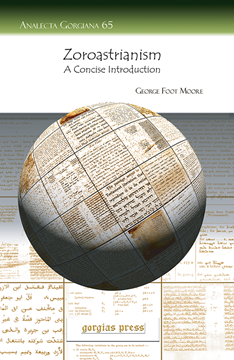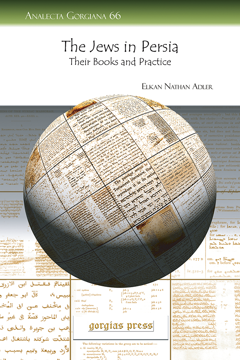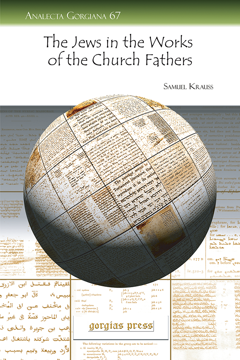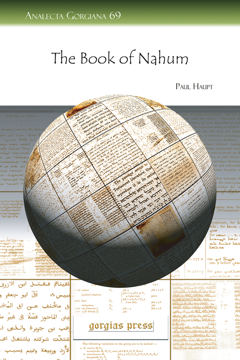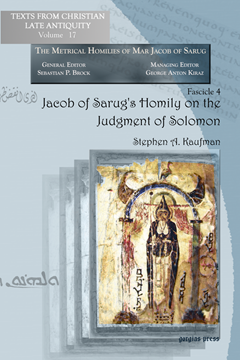Zoroastrianism
A Concise Introduction
By George Moore
Series: Analecta Gorgiana 65
ISBN: 978-1-59333-881-7
This work is an excellent, concise history of the development of the Zoroastrian religion. Special attention is given to the historical development of the religion from monotheism to a dualistic system, with particular emphasis on ethical and eschatological teachings.
$42.00 (USD) $25.20 (USD)
The Jews in Persia
Their Books and Practice
Series: Analecta Gorgiana 66
ISBN: 978-1-59333-882-4
This essay provides a detailed description of each manuscript the author acquired during this sojourn among the Jews of Persia. A discussion of the rituals of the Jewish people which the author met offers great insight into their liturgical life.
$41.00 (USD) $24.60 (USD)
The Jews in the Works of the Church Fathers
Sources for Understanding the Agaddah
Series: Analecta Gorgiana 67
ISBN: 978-1-59333-883-1
In this stellar study of what the works of select patristic authors (Justin Martyr, Clement of Alexandria, Origen, Eusebius Ephraem, and Jerome) reveal about the Aggadah, Samuel Krauss offers an insightful and provocative reading of the sources.
$53.00 (USD) $31.80 (USD)
The Book of Micah
Translation, Commentary, Notes and Edited Text
By Paul Haupt
Series: Analecta Gorgiana 68
ISBN: 978-1-59333-884-8
This work is a compilation of two articles by Professor Haupt on the book of Micah. Together, these articles provide an excellent resource for the study of the book of Micah, both for the layperson and the scholar.
$59.00 (USD) $35.40 (USD)
The Book of Nahum
Translation, Commentary, Notes and Edited Text
By Paul Haupt
Series: Analecta Gorgiana 69
ISBN: 978-1-59333-885-5
Presenting an original translation with introduction and commentary as well as an edited Hebrew text along with critical notes, this is an excellent resource for the study of the book of Nahum, both for the layperson and the scholar.
$43.00 (USD) $25.80 (USD)
Language and Heresy in Ismaili Thought
The Kitab al-Zina of Abu Hatim al-Razi
By Jamal Ali
Series: Gorgias Islamic Studies 2
ISBN: 978-1-59333-781-0
The heretofore unpublished Kitab al-Zina, virtually unknown in western scholarship, is a glossary of important Islamic terms by the 9th/10th-century Ismaili polymath Abu Hatim al-Razi. Some lament that Razi’s historical approach to etymology failed to catch on and that had it done so, the face of Arabic dictionary writing might have been altered for the better. His organization of material was uniquely Ismaili as he took pains to synthesize contradictory information into a harmonious whole. This study examines sections of Razi’s work with a view towards his contributions to the field of grammar and linguistics.
$135.00 (USD) $81.00 (USD)
The Book of Canticles
Translation, Commentary, Notes and Edited Text
By Paul Haupt
Series: Analecta Gorgiana 74
ISBN: 978-1-59333-887-9
This work is a compilation of three articles by Professor Haupt on the Book of Canticles, also known as the Song of Songs. It is an excellent resource for study, both for the layperson and the scholar.
$57.00 (USD) $34.20 (USD)
The Medieval Legend of Judas Iscariot
Its History and Diffusion
Series: Analecta Gorgiana 73
ISBN: 978-1-59333-888-6
Professor Baum provides the reader with an in depth study of the Life of Judas the Betrayer, which obviously mirrors the story of Oedipus, and its various recensions, as well as a study of the English ballad of Judas Iscariot.
$70.00 (USD) $42.00 (USD)
The Septuagint Text of Hosea Compared with the Massoretic Text
Series: Analecta Gorgiana 75
ISBN: 978-1-59333-889-3
This essay takes a text critical approach to the comparison between the Septuagint and Massoretic texts of Hosea. Its reproduction seems timely as Septuagint studies have seen increased interest in recent times.
$41.00 (USD) $24.60 (USD)
Jacob of Sarug’s Homily on the Judgment of Solomon
Metrical Homilies of Mar Jacob of Sarug
Series: Texts from Christian Late Antiquity 17
ISBN: 978-1-59333-972-2
This edition of Mar Jacob of Sarug's (d. 521) homily on the story of Solomon and the two harlots imagines the emotional state of the new king Solomon as he sits on his throne uncertain of his ability to rule and judge. The volume constitutes a fascicle of The Metrical Homilies of Mar Jacob of Sarug, which, when complete, will contain the original Syriac text of Jacob's surviving sermons, fully vocalized, alongside an annotated English translation.
$29.00 (USD) $17.40 (USD)
